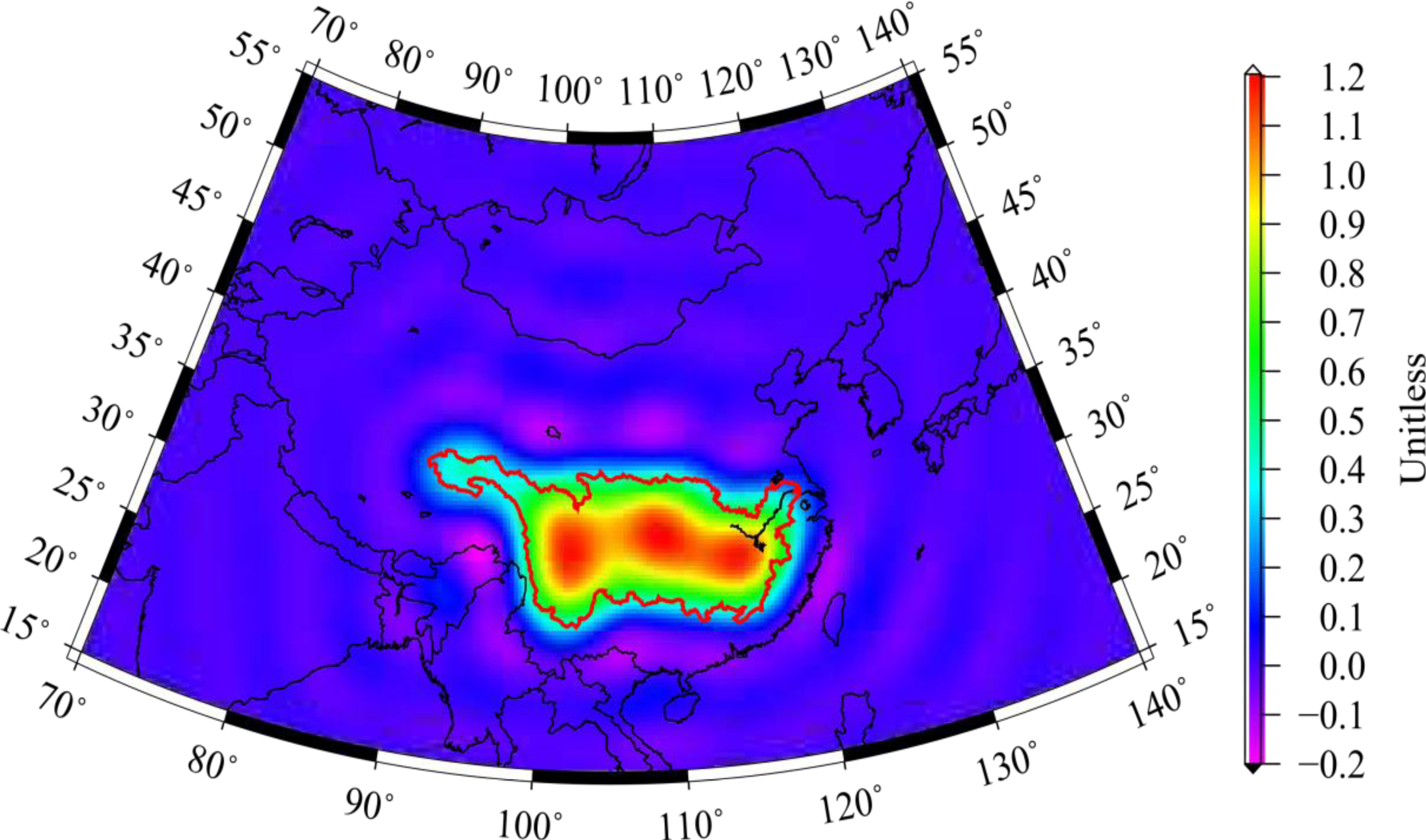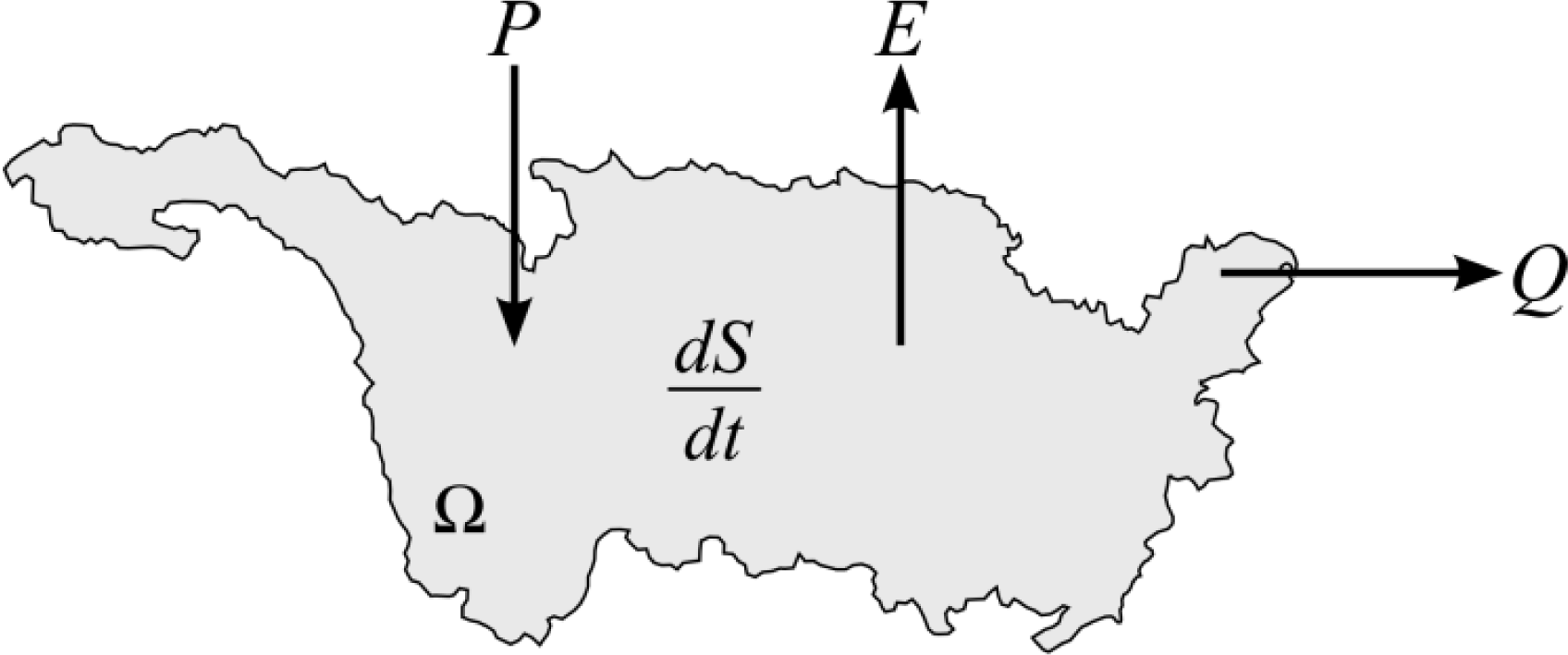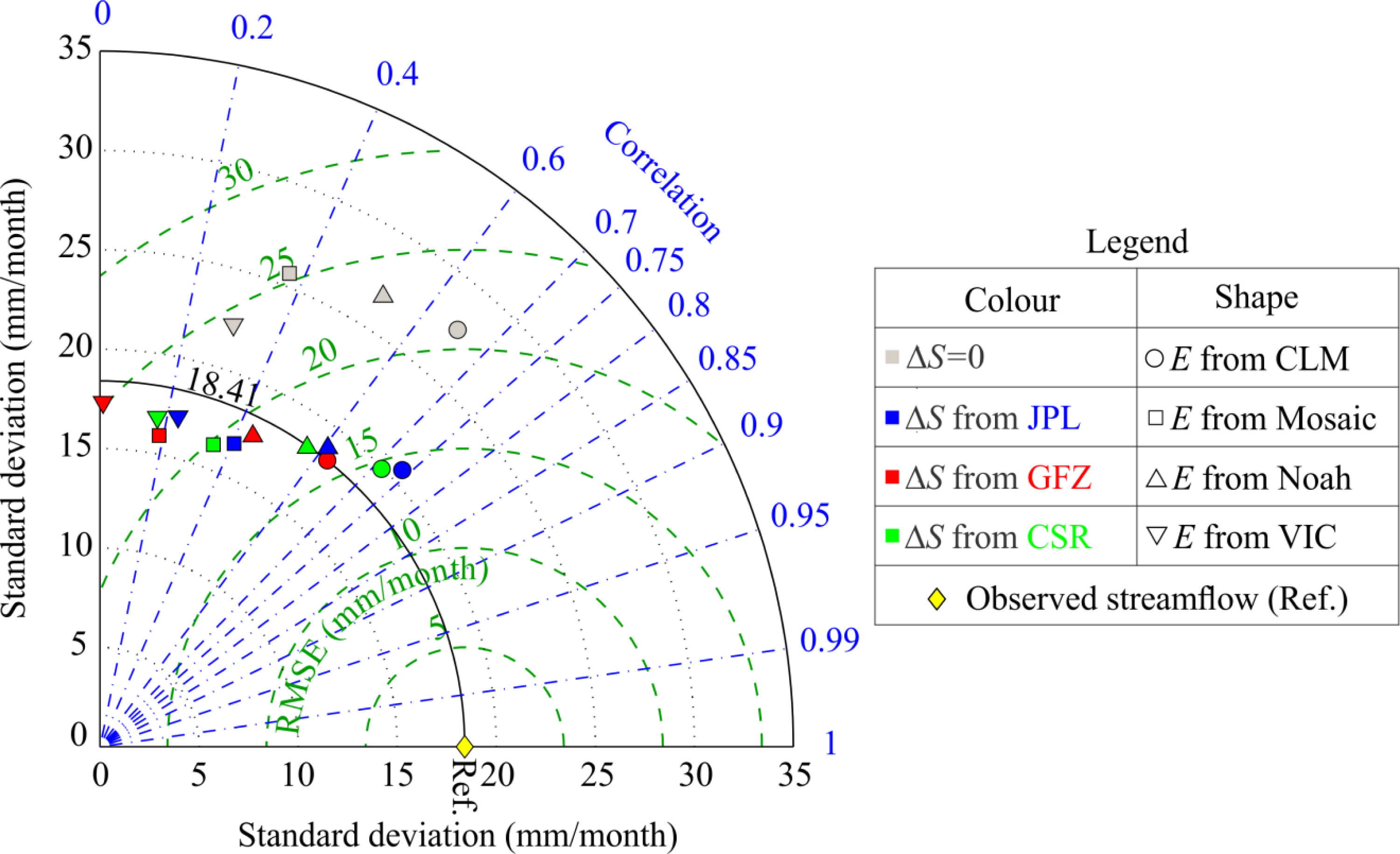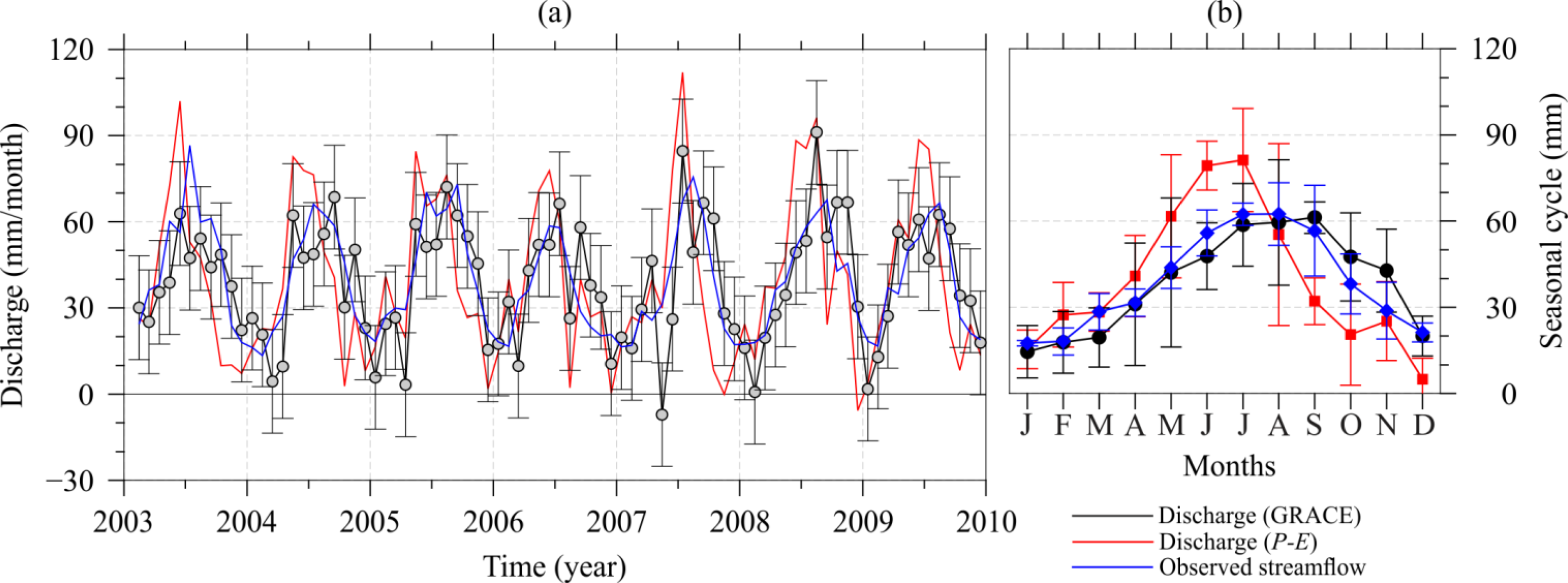Estimating Total Discharge in the Yangtze River Basin Using Satellite-Based Observations
Abstract
:1. Introduction
2. Methods and Data Sources
2.1. Datasets
2.1.1. Study Area and In Situ Discharge of Yangtze River
2.1.2. Precipitation Data
2.1.3. Hydrological Models
2.1.4. GRACE Level 2 Products
2.2. Methodology
2.2.1. Computation of Water-Storage Variations from GRACE
2.2.2. Computation of Total Discharge using Terrestrial Water Budget
3. Results and Discussion
4. Conclusions
Acknowledgments
Conflict of Interest
References
- Cazenave, A.; Chen, J. Time-variable gravity from space and present-day mass redistribution in the Earth system. Earth Planet. Sci. Lett 2010, 298, 263–274. [Google Scholar]
- Chen, J.L.; Wilson, C.R.; Tapley, B.D.; Yang, Z.L.; Niu, G.Y. 2005 drought event in the Amazon River basin as measured by GRACE and estimated by climate models. J. Geophys. Res 2009, 114, B05404. [Google Scholar]
- Frappart, F.; Ramillien, G.; Ronchail, J. Changes in terrestrial water storage versus rainfall and discharges in the Amazon basin. Int. J. Climatol. 2013. [Google Scholar] [CrossRef] [Green Version]
- Pokhrel, Y.N.; Fan, Y.; Miguez-Macho, G.; Yeh, P.J.-F.; Han, S.-C. The role of groundwater in the Amazon water cycle: 3. Influence on terrestrial water storage computations and comparison with GRACE. J. Geophys. Res.-Atmos 2013, 118, 3233–3244. [Google Scholar]
- Schmidt, R.; Schwintzer, P.; Flechtner, F.; Reigber, C.; Güntner, A.; Döll, P.; Ramillien, G.; Cazenave, A.; Petrovic, S.; Jochmann, H.; et al. GRACE observations of changes in continental water storage. Global Planet. Chang 2006, 50, 112–126. [Google Scholar]
- Crowley, J.W.; Mitrovica, J.X.; Bailey, R.C.; Tamisiea, M.E.; Davis, J.L. Land water storage within the Congo Basin inferred from GRACE satellite gravity data. Geophys. Res. Lett 2006, 33, L19402. [Google Scholar]
- Syed, T.H.; Famiglietti, J.S.; Rodell, M.; Chen, J.; Wilson, C.R. Analysis of terrestrial water storage changes from GRACE and GLDAS. Water Resour. Res 2008, 44, W02433. [Google Scholar]
- Hu, X.; Chen, J.; Zhou, Y.; Huang, C.; Liao, X. Seasonal water storage change of the Yangtze River basin detected by GRACE. Sci. China Ser. D 2006, 49, 483–491. [Google Scholar]
- Rodell, M.; Velicogna, I.; Famiglietti, J.S. Satellite-based estimates of groundwater depletion in India. Nature 2009, 460, 999–1002. [Google Scholar]
- Jacob, T.; Wahr, J.; Pfeffer, W.T.; Swenson, S. Recent contributions of glaciers and ice caps to sea level rise. Nature 2012, 482, 514–518. [Google Scholar]
- Chen, J.L.; Wilson, C.R.; Tapley, B.D. Contribution of ice sheet and mountain glacier melt to recent sea level rise. Nat. Geosci 2013, 6, 549–552. [Google Scholar]
- Velicogna, I. Increasing rates of ice mass loss from the Greenland and Antarctic ice sheets revealed by GRACE. Geophys. Res. Lett 2009, 36, L19503. [Google Scholar]
- Luthcke, S.B.; Zwally, H.J.; Abdalati, W.; Rowlands, D.D.; Ray, R.D.; Nerem, R.S.; Lemoine, F.G.; McCarthy, J.J.; Chinn, D.S. Recent Greenland ice mass loss by drainage system from satellite gravity observations. Science 2006, 314, 1286–1289. [Google Scholar]
- Chen, J.L.; Wilson, C.R.; Tapley, B.D. Interannual variability of Greenland ice losses from satellite gravimetry. J. Geophysi. Res 2011, 116, B07406. [Google Scholar]
- Bergmann, I.; Ramillien, G.; Frappart, F. Climate-driven interannual ice mass evolution in Greenland. Global Planet. Chang. 2012, 82–83, 1–11. [Google Scholar]
- Muskett, R.R.; Romanovsky, V.E. Alaskan permafrost groundwater storage changes derived from GRACE and ground measurements. Remote Sens 2011, 3, 378–397. [Google Scholar]
- Wang, W.; Xing, W.; Yang, T.; Shao, Q.; Peng, S.; Yu, Z.; Yong, B. Characterizing the changing behaviours of precipitation concentration in the Yangtze River Basin, China. Hydrol. Process. 2012. [Google Scholar] [CrossRef]
- Wang, H.-S.; Wang, Z.-Y.; Yuan, X.-D.; Wu, P.; Rangelova, E. Water storage changes in Three Gorges water systems area inferred from GRACE time-variable gravity data. Chin. J. Geophys 2007, 50, 650–657. [Google Scholar]
- Zhao, Q.-L.; Liu, X.-L.; Ditmar, P.; Siemes, C.; Revtova, E.; Hashemi-Farahani, H.; Klees, R. Water storage variations of the Yangtze, Yellow, and Zhujiang river basins derived from the DEOS Mass Transport (DMT-1) model. Sci. China Earth Sci 2010, 54, 667–677. [Google Scholar]
- Huang, Y.; Salama, M.S.; Krol, M.S.; van der Velde, R.; Hoekstra, A.Y.; Zhou, Y.; Su, Z. Analysis of long-term terrestrial water storage variations in Yangtze River basin. Hydrol. Earth Syst. Sci 2012, 9, 11487–11520. [Google Scholar]
- Huang, H.; Song, D.S.; Yun, H.S.; Lee, D.H.; Cho, J.M. Water level change caused from three gorges dam construction in Yangtze River Basin. Proceedings of the 11th International Coastal Symposium, Szczecin, Poland, 9–14 May 2011; pp. 1672–1675.
- Wang, X.; de Linage, C.; Famiglietti, J.; Zender, C.S. Gravity Recovery and Climate Experiment (GRACE) detection of water storage changes in the Three Gorges Reservoir of China and comparison with in situ measurements. Water Resour. Res 2011, 47, W12502. [Google Scholar]
- Syed, T.H.; Famiglietti, J.S.; Chen, J.; Rodell, M.; Seneviratne, S.I.; Viterbo, P.; Wilson, C.R. Total basin discharge for the Amazon and Mississippi River basins from GRACE and a land-atmosphere water balance. Geophys. Res. Lett 2005, 32, L24404. [Google Scholar]
- Syed, T.H.; Famiglietti, J.S.; Zlotnicki, V.; Rodell, M. Contemporary estimates of Pan-Arctic freshwater discharge from GRACE and reanalysis. Geophys. Res. Lett 2007, 34, L19404. [Google Scholar]
- Syed, T.H.; Famiglietti, J.S.; Chambers, D.P. GRACE-based estimates of terrestrial freshwater discharge from basin to continental scales. J. Hydromet 2009, 10, 22–40. [Google Scholar]
- Seo, K.-W.; Waliser, D.E.; Tian, B.; Famiglietti, J.S.; Syed, T.H. Evaluation of global land-to-ocean fresh water discharge and evapotranspiration using space-based observations. J. Hydrol 2009, 373, 508–515. [Google Scholar]
- Rodell, M.; Houser, P.R.; Jambor, U.; Gottschalck, J.; Mitchell, K.; Meng, C.-J.; Arsenault, K.; Cosgrove, B.; Radakovich, J.; Bosilovich, M.; et al. The global land data assimilation system. Bull. Am. Meteorol. Soc 2004, 85, 381–394. [Google Scholar]
- Huffman, G.J.; Adler, R.F.; Bolvin, D.T.; Gu, G.; Nelkin, E.J.; Bowman, K.P.; Hong, Y.; Stocker, E.F.; Wolff, D.B. The TRMM Multisatellite Precipitation Analysis (TMPA): Quasi-global, multiyear, combined-sensor precipitation estimates at fine scales. J. Hydrometeorol 2007, 8, 38–55. [Google Scholar]
- Koster, R.D.; Suarez, M.J. Modeling the land surface boundary in climate models as a composite of independent vegetation stands. J. Geophys. Res 1992, 97, 2697. [Google Scholar]
- Liang, X.; Lettenmaier, D.P.; Wood, E.F.; Burges, S.J. A simple hydrologically based model of land surface water and energy fluxes for general circulation models. J. Geophys. Res 1994, 99, 14415. [Google Scholar]
- Ek, M.B. Implementation of Noah land surface model advances in the national centers for environmental prediction operational mesoscale Eta model. J. Geophys. Res 2003, 108, 8851. [Google Scholar]
- Klees, R.; Liu, X.; Wittwer, T.; Gunter, B.C.; Revtova, E.A.; Tenzer, R.; Ditmar, P.; Winsemius, H.C.; Savenije, H.H.G. A comparison of global and regional GRACE models for land hydrology. Surv. Geophys 2008, 29, 335–359. [Google Scholar]
- Cheng, M.; Tapley, B.D. Variations in the Earth’s oblateness during the past 28 years. J. Geophys. Res 2004, 109, B09402. [Google Scholar]
- Swenson, S.; Chambers, D.; Wahr, J. Estimating geocenter variations from a combination of GRACE and ocean model output. J. Geophys. Res 2008, 113, B08410. [Google Scholar]
- Wahr, J.; Molenaar, M.; Bryan, F. Time variability of the Earth’s gravity field: Hydrological and oceanic effects and their possible detection using GRACE. J. Geophys. Res 1998, 103, 30205–30229. [Google Scholar]
- Ramillien, G.; Frappart, F.; Güntner, A.; Ngo-Duc, T.; Cazenave, A.; Laval, K. Time-variations of the regional evapotranspiration rate from GRACE satellite gravimetry. Water Resour. Res 2006, 42, W10403. [Google Scholar]
- Chen, J.L.; Wilson, C.R.; Famiglietti, J.S.; Rodell, M. Spatial sensitivity of the Gravity Recovery and Climate Experiment (GRACE) time-variable gravity observations. J. Geophys. Res 2005, 110, B08408. [Google Scholar]
- Swenson, S.; Wahr, J. Post-processing removal of correlated errors in GRACE data. Geophys. Res. Lett 2006, 33, L08402. [Google Scholar]
- Kusche, J. Approximate decorrelation and non-isotropic smoothing of time-variable GRACE-type gravity field models. J. Geodesy 2007, 81, 733–749. [Google Scholar]
- Chen, J.L.; Wilson, C.R.; Tapley, B.D.; Grand, S. GRACE detects coseismic and postseismic deformation from the Sumatra-Andaman earthquake. Geophys. Res. Lett 2007, 34, L13302. [Google Scholar]
- Chen, J.L.; Wilson, C.R.; Tapley, B.D.; Longuevergne, L.; Yang, Z.L.; Scanlon, B.R. Recent La Plata basin drought conditions observed by satellite gravimetry. J. Geophy. Res 2010, 115, D22108. [Google Scholar]
- Swenson, S.; Wahr, J. Methods for inferring regional surface-mass anomalies from Gravity Recovery and Climate Experiment (GRACE) measurements of time-variable gravity. J. Geophys. Res. 2002. [Google Scholar] [CrossRef]
- Klees, R.; Zapreeva, E.A.; Winsemius, H.C.; Savenije, H.H.G. The bias in GRACE estimates of continental water storage variations. Hydrol. Earth Syst. Sci 2007, 11, 1227–1241. [Google Scholar]
- Landerer, F.W.; Swenson, S.C. Accuracy of scaled GRACE terrestrial water storage estimates. Water Resour. Res 2012, 48, W04531. [Google Scholar]
- Brutsaert, W. Hydrology: An Introduction; Cambridge University Press: New York, NY, USA, 2005; p. 142. [Google Scholar]
- Xue, B.-L.; Wang, L.; Li, X.; Yang, K.; Chen, D.; Sun, L. Evaluation of evapotranspiration estimates for two river basins on the Tibetan Plateau by a water balance method. J. Hydrol 2013, 492, 290–297. [Google Scholar]
- Rodell, M.; Famiglietti, J.S.; Chen, J.; Seneviratne, S.I.; Viterbo, P.; Holl, S.; Wilson, C.R. Basin scale estimates of evapotranspiration using GRACE and other observations. Geophys. Res. Lett 2004, 31, L20504. [Google Scholar]
- Cesanelli, A.; Guarracino, L. Estimation of regional evapotranspiration in the extended Salado Basin (Argentina) from satellite gravity measurements. Hydrogeol. J 2011, 19, 629–639. [Google Scholar]
- Taylor, K.E. Summarizing multiple aspects of model performance in a single diagram. J. Geophys. Res 2001, 106, 7183–7192. [Google Scholar]
- Zaitchik, B.F.; Rodell, M.; Olivera, F. Evaluation of the global land data assimilation system using global river discharge data and a source-to-sink routing scheme. Water Resour. Res 2010, 46, W06507. [Google Scholar]






| Variables | Annual | Semi-Annual | ||
|---|---|---|---|---|
| Amplitude (mm/month) | Phase (month) | Amplitude (mm/month) | Phase (month) | |
| Obs. streamflow | 23.4 ±1.3 | 6.8 ±0.1 | 2.7 ±1.3 | 2.8 ±0.9 |
| Discharge (GRACE) | 22.0 ±2.2 | 7.3 ±0.2 | 2.5 ±2.2 | 6.6 ±1.7 |
| Discharge (P – E) | 32.0 ±2.4 | 5.6 ±0.1 | 8.4 ±2.4 | 11.8 ±0.5 |
© 2013 by the authors; licensee MDPI, Basel, Switzerland This article is an open access article distributed under the terms and conditions of the Creative Commons Attribution license (http://creativecommons.org/licenses/by/3.0/).
Share and Cite
Ferreira, V.G.; Gong, Z.; He, X.; Zhang, Y.; Andam‑Akorful, S.A. Estimating Total Discharge in the Yangtze River Basin Using Satellite-Based Observations. Remote Sens. 2013, 5, 3415-3430. https://doi.org/10.3390/rs5073415
Ferreira VG, Gong Z, He X, Zhang Y, Andam‑Akorful SA. Estimating Total Discharge in the Yangtze River Basin Using Satellite-Based Observations. Remote Sensing. 2013; 5(7):3415-3430. https://doi.org/10.3390/rs5073415
Chicago/Turabian StyleFerreira, Vagner G., Zheng Gong, Xiufeng He, Yonglei Zhang, and Samuel A. Andam‑Akorful. 2013. "Estimating Total Discharge in the Yangtze River Basin Using Satellite-Based Observations" Remote Sensing 5, no. 7: 3415-3430. https://doi.org/10.3390/rs5073415






